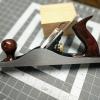Hi,
I recently purchased an early model MF No. 2 hand drill. It's in really good shape minus a missing side knob and I'm excited to fully restore it. I'm having some difficulty, however, it disassembling it. I've got most of it apart, but am unsure how to remove the main handle. It seems that it's pinned through the ferrule. For those of you who know, do I simply need to remove this pin? And is it then just a matter of screwing it off?
Also, is there a way to remove the crank's handle? This seems to be riveted on, I'm afraid there will be no way of remounting it if I cut the head of the rivet off. Any advice?
Lastly, I am unsure how to remove the drive shaft with the small gear on it. It seems there's a single pin I'd have to remove and replace. I'd like to remove it as it would make painting the body much easier, but don't know whether this would be opening a can of worms. Any advice and whether I should bother and how to go about it?
Thanks for your help!




 Reply With Quote
Reply With Quote


